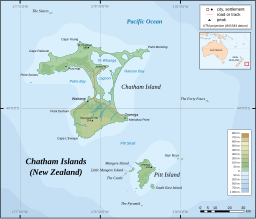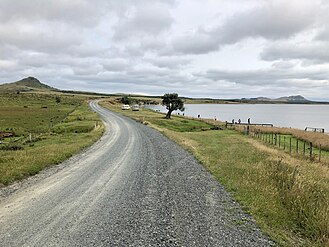| Te Whanga Lagoon | |
|---|---|
 | |
 The Chatham Islands from space The Chatham Islands from space | |
| Location | Chatham Island |
| Coordinates | 43°52′S 176°28′W / 43.867°S 176.467°W / -43.867; -176.467 |
| Basin countries | New Zealand |
| Surface area | 150 square kilometres (58 sq mi) |
Te Whanga Lagoon dominates the geography of Chatham Island, in the South Pacific Ocean off New Zealand's east coast. It covers 160 square kilometres (62 sq mi).
It is the outflow of several small rivers in the island's hilly south, and drains to the Pacific via gaps in Hanson Bay on the east coast of the island.
It contains many fossilized shark teeth that can be collected from the edges of the lagoon. Over time the lagoon is likely to silt up.
When first described by Dr E Dieffenbach in 1841, the lagoon was only slightly brackish and separated from the sea by a low sand bar and was about 2 feet (0.61 m) above high tide.
Gallery
-
 Hikurangi Channel, Te Whanga Lagoon. This drainage channel was dug in the 1880s to give more farmland
Hikurangi Channel, Te Whanga Lagoon. This drainage channel was dug in the 1880s to give more farmland
-
 Waikato Point. Cliffs rise to about 30 m (98 ft) on the west coast of the lagoon
Waikato Point. Cliffs rise to about 30 m (98 ft) on the west coast of the lagoon
-
 Te Whanga Lagoon at Blind Jims Creek. 178m Korako is to the left, 149m Rangitihi and 188m Mt Chudleigh to the right.
Te Whanga Lagoon at Blind Jims Creek. 178m Korako is to the left, 149m Rangitihi and 188m Mt Chudleigh to the right.
-
 Cattle Point, Te Whanga Lagoon
Cattle Point, Te Whanga Lagoon
References
- "Story: Chatham Islands". web page. The Encyclopedia of New Zealand. 7 September 2012. Retrieved 15 December 2012.
- "Story: Chatham Islands". web page. The Encyclopedia of New Zealand. 7 September 2012. Retrieved 15 December 2012.
- Williams, Gary (June 1995). "A Report on the Nature of Te Whanga Lagoon, and the Way in which it has Changed since 1840" (PDF).
| Chatham Islands | ||
|---|---|---|
| Islands (by English name) |  | |
| Islands (by Māori/Moriori name) | ||
| Coastal landforms | ||
| Populated places | ||
| Other geographic features | ||
| Historical events | ||
This article about the geography of New Zealand's outlying islands is a stub. You can help Misplaced Pages by expanding it. |